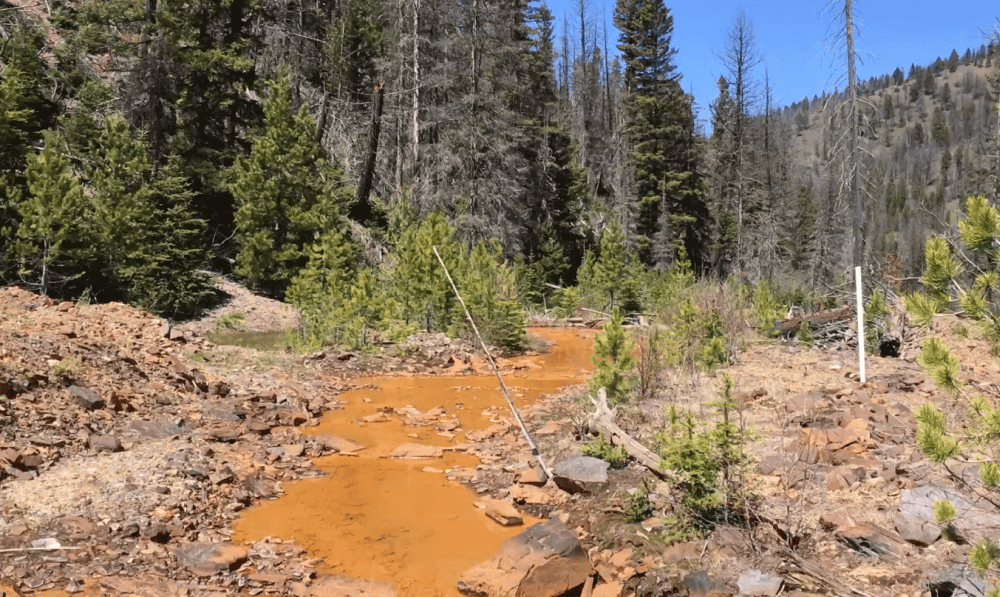
[Image above] Acid mine drainage from the Mike Horse Mine complex in Montana. Acid drainage is often marked by “yellow boy,” a yellowish-orange substance that occurs when the pH of acidic mine drainage rises above pH 3, so that the previously dissolved iron precipitates out. Credit: EARTHWORKS, Flickr (CC BY 2.0)
This year is expected to be a big one for clean energy—solar is set to overtake the amount of investment going into oil production for the first time, according to the International Energy Agency.
But while the use of clean energy technology leads to lower emissions, the creation of these devices relies on a wide range of minerals. And mining these resources comes with a cost.
“Extracting these minerals also requires energy and freshwater, and produces greenhouse gas emissions and waste. Mining can be dangerous for workers and, in certain places, is tied to labor and human rights abuses. Surrounding communities, often in low-income or developing areas, disproportionately shoulder these burdens, leading to a tangle of land-use and environmental justice conflicts,” an article on the Massachusetts Institute of Technology Climate Portal explains.
The rapid growth of the global mining sector in the past two decades has exacerbated these costs. With this growth projected to continue as demand for clean energy technologies expands, it is crucial that miners adopt improved regulations and lower-impact methods to reduce the sector’s environmental and social footprint.
Ceramics play an important role in environmental remediation. In honor of World Environment Day, which took place yesterday, today’s CTT highlights two studies on the use of ceramics to treat acid mine drainage.
Acid mine drainage: a major water quality problem
Mine drainage refers to water that is polluted from contact with mining activity. There are several ways in which mines impact water quality, but acid mine drainage is the most prevalent.
Acid mine drainage is the formation and movement of highly acidic water rich in heavy metals. It forms through the chemical reaction of surface water (e.g., rainwater, snowmelt, pond water) and shallow subsurface water with rocks that contain sulfur-bearing minerals, resulting in sulfuric acid. Heavy metals can be leached from rocks that encounter the acid, a process that may be substantially enhanced by bacterial action.
Many streams impacted by acid mine drainage have a pH of 4 or lower—similar to battery acid. Unsurprisingly, such acidity can severely affect fish, animals, and plants.
Acid mine drainage is especially harmful because it can occur indefinitely, even after mining has ended. As such, remediation of acid mine drainage must be a purposeful and active process.
Long-term treatment of acid mine drainage by alkali diffusion ceramic reactor
In July 2022, researchers from several organizations and universities in Korea described a novel alkali diffusion reactor that they designed for the long-term remediation of acid mine drainage.
Traditionally, acid mine drainage is remediated by using neutralizing chemicals to increase pH and promote metal precipitation. But current systems struggle to provide long-term treatment because of the gradual depletion of the treatment agent and operating energy.
“Therefore, more research is needed to develop a continuous and cost-effective treatment technology which can sustain persistent and long-term AMD [acid mine drainage] loads,” the researchers write.
Their new alkali diffusion reactor consists of porous ceramic columns that release neutralizing chemicals without any electrical devices, such as pumps, pH adjusters, chemicals injectors, or churners. The column’s irregular pore morphology and smaller pore size allows for longer-term release and consumption of the neutralizing chemicals.
Testing revealed that the system—featuring sodium bicarbonate as the neutralizing material and activated carbon as the filling material—could remediate acidity and metals in acid mine drainage for up to a year without electricity or additional neutralizing chemicals. The system could also be reused at least five times with no appreciable loss in activity.
“In conclusion, the proposed system can be applied to mining areas where the passive system is insufficient because of low efficiency, and the active system is not affordable because of budget limitations and geological sites,” the researchers conclude.
The paper, published in Chemosphere, is “Long-term treatment of acid mine drainage by alkali diffusion ceramic reactor: Simultaneous metal removal mechanisms” (DOI: 10.1016/j.chemosphere.2022.134186).
Porous titania beads for remediation of arsenic contamination
In April 2023, researchers from several organizations and universities in Australia developed porous titanium dioxide (titania) bead adsorbents to remove arsenic from acid mine drainage.
As noted earlier, acid mine drainage is a mixture of highly acidic water with various heavy metals. Due to this variability in chemical composition and pH, acid mine drainage prevention and treatment are complex and site-specific.
Some contaminants, such as arsenic, cannot be adequately removed through the conventional neutralization methods. Instead, adsorption—or the adhesion of atoms or molecules to the surface of a solid substance (the adsorbent)—provides a way to remove these contaminations.
Many adsorbents demonstrate poor adsorption or chemical instability in acidic conditions below pH 3. Titania, on the other hand, demonstrates high chemical stability over a wide pH range, as well as photocatalytic activity, low cost, and nontoxicity.
The researchers found that their titania beads could successfully and selectively remove arsenic from simulated and real acid mine drainage solutions with pH as low as 2.6. This preferential removal was retained even when the concentration of iron(II + III)—which is typically found in large amounts in acid mine drainage—was two orders of magnitude higher than that of the arsenic.
In this case, titania beads that were not functionalized demonstrated superior adsorption capabilities than ones that were functionalized with a primary amine.
“However, functionalization with an amine or other functional group may produce an adsorbent better suited to remediation of other sites affected by AMD [acid mine drainage],” the researchers write.
The paper, published in Journal of Environmental Management, is “Porous titania beads for remediation of arsenic contamination from acid mine drainage” (DOI: 10.1016/j.jenvman.2023.117384).
Author
Lisa McDonald
CTT Categories
- Environment


